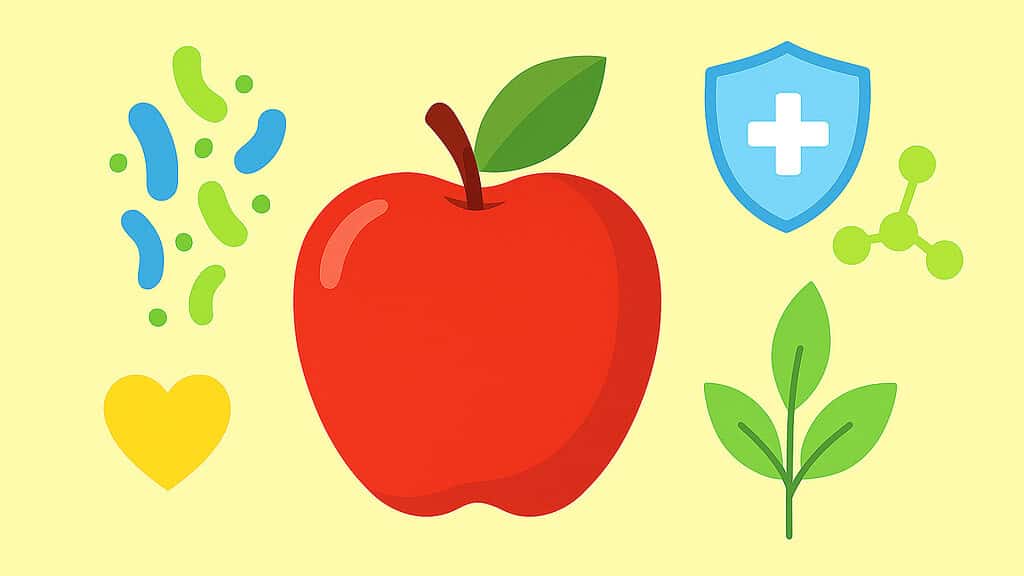Table of Contents
Introduction: Apples and the Hidden World Inside Your Gut
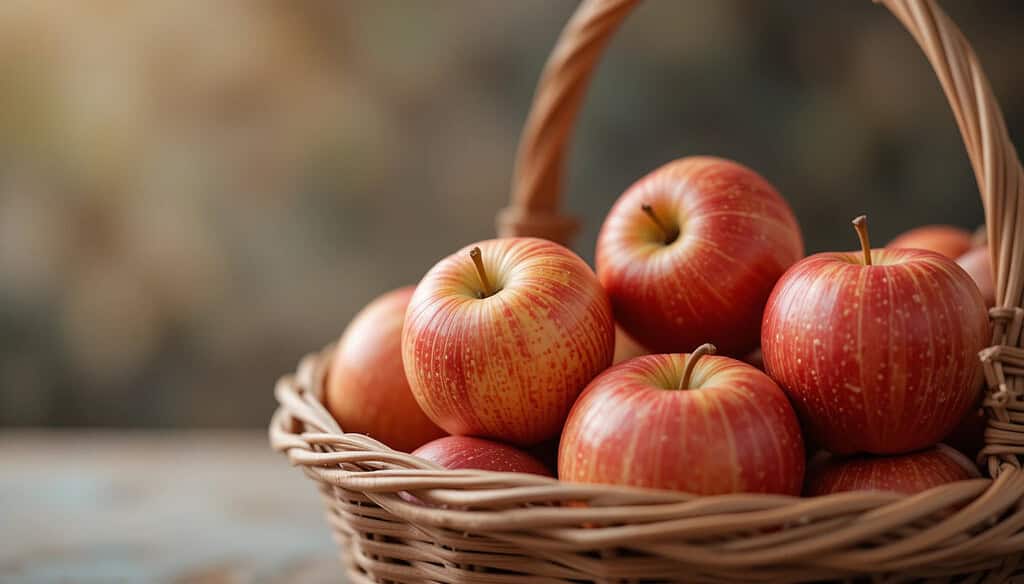
Picture this: every time you bite into a crisp apple, you’re feeding trillions of microscopic workers living in your digestive system. These aren’t just any workers—they’re the architects of your health, quietly shaping everything from your immune response to your mood and metabolism.
The microbiome in your gut contains a greater number of bacterial cells than the human cells present in your body. This bustling ecosystem determines whether you wake up energized or sluggish, whether your immune system fights off infections effectively, and even whether you feel happy or anxious. The food you choose becomes the building material for this inner world.
Apples, scientifically known as Malus domestica, belong to the Rosaceae, one of the important fruit families. These humble fruits carry a sophisticated arsenal of compounds that transform your gut environment in six brilliant ways. From feeding beneficial bacteria to strengthening your intestinal walls, apples work as natural prebiotics that support your body’s most complex ecosystem.
Research reveals that apples don’t just provide nutrition—they actively reshape the bacterial landscape inside you. Their unique combination of soluble fiber, polyphenols, and other bioactive compounds creates a ripple effect throughout your digestive system, influencing everything from inflammation levels to neurotransmitter production.
This article unveils six science-backed benefits that make apples true gut health champions. You’ll discover how these common fruits perform extraordinary feats inside your body, supported by clinical evidence and practical applications for daily life.
Apples vs. Other Rosaceae Fruits: A Family Comparison
| Fruit | Scientific Name | Key Gut-Beneficial Compounds | Fiber Content (per 100g) | Notable Characteristics |
|---|---|---|---|---|
| Apples | Malus domestica | Pectin, quercetin, chlorogenic acid | 2.4g | High pectin content, diverse polyphenols |
| Pears | Pyrus communis | Pectin, arbutin, catechins | 3.1g | Higher fiber than apples, similar pectin benefits |
| Cherries | Prunus avium | Anthocyanins, cyanidin | 2.1g | Rich in anti-inflammatory compounds |
| Peaches | Prunus persica | Beta-carotene, chlorogenic acid | 1.5g | Lower fiber, moderate polyphenol content |
| Plums | Prunus domestica | Anthocyanins, phenolic acids | 1.4g | Good antioxidant profile, moderate fiber |
| Strawberries | Fragaria × ananassa | Anthocyanins, ellagic acid | 2.0g | High vitamin C, good polyphenol diversity |
| Apricots | Prunus armeniaca | Beta-carotene, chlorogenic acid | 2.0g | Moderate fiber and polyphenol content |
| Raspberries | Rubus idaeus | Ellagic acid, anthocyanins | 6.5g | Highest fiber in family, excellent prebiotic potential |
1. Apples and Pectin as Prebiotic Fuel

Within the core of apple flesh resides an extraordinary molecule known as pectin, a soluble fiber that serves as high-quality nourishment for your advantageous gut bacteria. Unlike insoluble fiber that simply adds bulk, pectin dissolves in water and forms a gel-like substance that creates the perfect feeding ground for specific bacterial strains.
When pectin reaches your colon, it becomes a selective feast for Bifidobacteria and Lactobacillus species—the good guys in your microbial community. These bacteria possess special enzymes that break down pectin’s complex structure, using it as their primary energy source. This selective feeding process is crucial because it allows beneficial bacteria to outcompete potentially harmful microorganisms.
Research demonstrates that apple pectin increases Bifidobacteria populations by up to 40% within just two weeks of regular consumption. These bacteria produce lactic acid, which creates an acidic environment that inhibits pathogenic bacteria while promoting overall gut health. The process works like a natural probiotic supplement, but with the added benefit of whole food nutrition.
What makes apple pectin particularly special is its molecular structure. The pectin in apples has a specific degree of methylation that makes it more readily fermentable than pectin from other sources. This means your gut bacteria can access and utilize apple pectin more efficiently than similar compounds from other fruits or supplements.
Studies show that people consuming two apples daily experience significant increases in beneficial bacteria populations compared to those eating other fruits with similar fiber content. The unique properties of apple pectin create a prebiotic effect that extends beyond simple fiber supplementation.
Pectin Content and Prebiotic Potential in Common Foods
| Food Source | Pectin Content (g per 100g) | Prebiotic Efficiency | Fermentation Rate | Primary Bacterial Beneficiaries |
|---|---|---|---|---|
| Apples (with peel) | 1.2-1.8g | High | Moderate-Fast | Bifidobacteria, Lactobacillus |
| Citrus fruits | 0.5-1.0g | Moderate | Fast | Bifidobacteria |
| Carrots | 0.7-1.2g | High | Slow | Bacteroides, Bifidobacteria |
| Sugar beets | 0.1-0.7g | Low | Very slow | Limited bacterial response |
| Tomatoes | 0.1-0.3g | Low | Moderate | Minimal prebiotic effect |
| Bananas | 0.7-1.2g | Moderate | Fast | Bifidobacteria |
2. Apples and Polyphenols: Nature’s Microbial Boosters
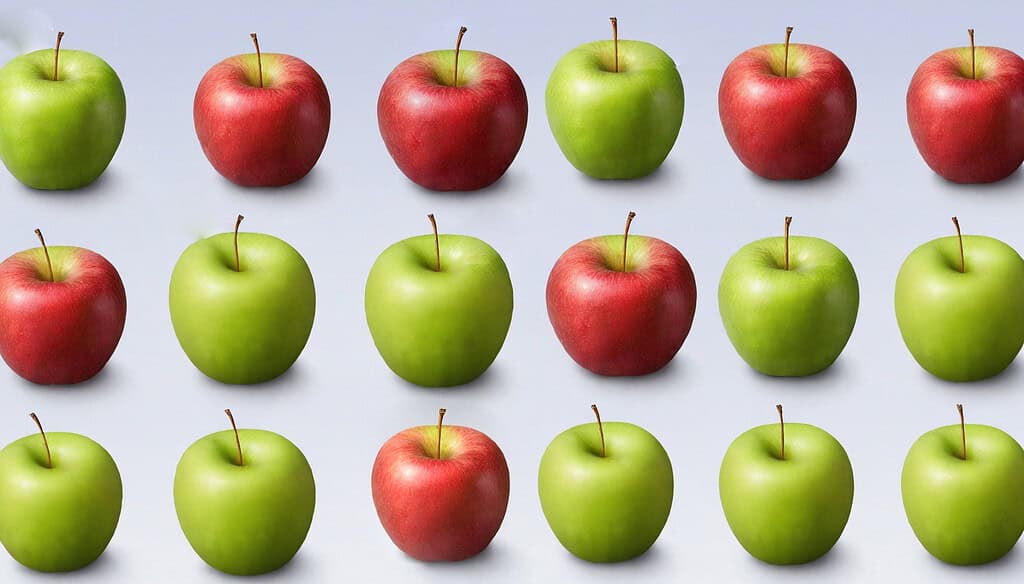
Beyond fiber, apples contain a sophisticated array of polyphenolic compounds that act as both antioxidants and microbial modulators. The primary players include quercetin, chlorogenic acid, catechins, and proanthocyanidins—each contributing to the complex orchestra of gut health improvement.
Quercetin, concentrated mainly in apple peels, demonstrates remarkable ability to increase microbial diversity in the gut. Clinical studies reveal that regular quercetin consumption promotes the growth of beneficial Akkermansia muciniphila, a keystone species that maintains gut barrier function and reduces inflammation throughout the body.
Chlorogenic acid, found throughout apple flesh, works differently by inhibiting harmful bacteria while supporting beneficial strains. This compound shows particular effectiveness against Escherichia coli and Clostridium perfringens, two bacteria associated with digestive distress and inflammation when present in excessive numbers.
The polyphenol profile of apples creates what researchers call a “prebiotic synergy.” Unlike isolated compounds, the combination of multiple polyphenols in whole apples produces effects greater than the sum of their individual parts. This synergy enhances the survival and activity of probiotic bacteria while simultaneously reducing populations of potentially harmful microorganisms.
Research indicates that people consuming polyphenol-rich apples show increased production of beneficial metabolites in their gut, including compounds that support immune function and reduce systemic inflammation. The diversity of apple polyphenols means they can interact with different bacterial species, creating a more robust and resilient gut ecosystem.
Polyphenol Content Comparison: Apples vs. Other Fruits
| Fruit | Total Polyphenols (mg per 100g) | Primary Polyphenols | Antioxidant Capacity (ORAC) | Microbial Modulation Effect |
|---|---|---|---|---|
| Apples (with peel) | 136-325mg | Quercetin, chlorogenic acid, catechins | 3,049 μmol TE/100g | High diversity promotion |
| Blueberries | 560-1,000mg | Anthocyanins, chlorogenic acid | 9,621 μmol TE/100g | Strong Bifidobacteria support |
| Grapes | 200-280mg | Resveratrol, catechins | 1,837 μmol TE/100g | Moderate microbial diversity |
| Oranges | 150-200mg | Hesperidin, naringenin | 1,819 μmol TE/100g | Good anti-inflammatory effect |
| Bananas | 75-100mg | Dopamine, catechins | 795 μmol TE/100g | Limited polyphenol activity |
| Strawberries | 235-280mg | Anthocyanins, ellagic acid | 4,302 μmol TE/100g | Strong antioxidant support |
3. Apples and Gut Barrier Protection Against Inflammation
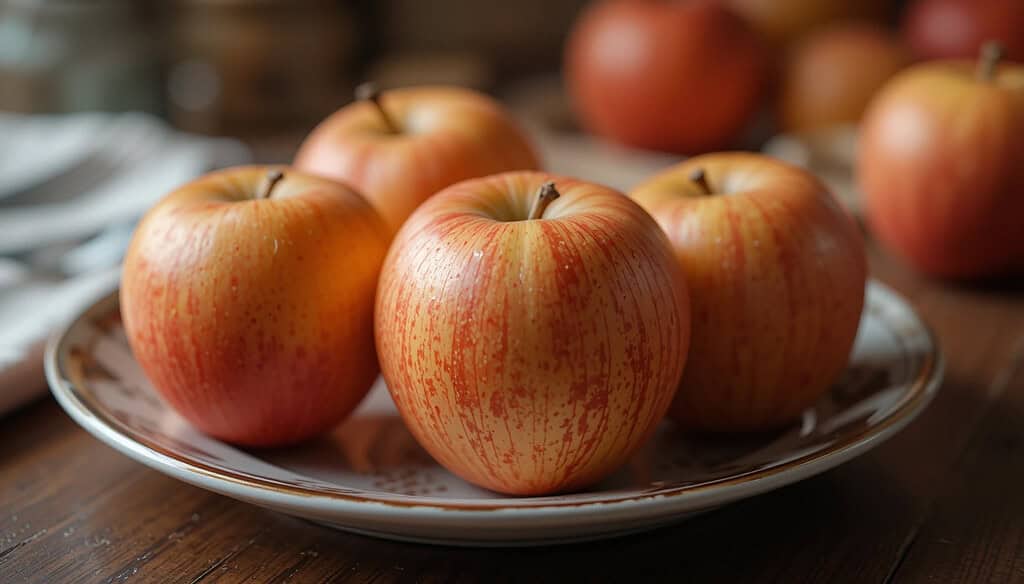
Your intestinal wall serves as a crucial barrier between your internal body and the outside world, and apples play a vital role in maintaining this protective fortress. The compounds in apples work together to strengthen tight junctions between intestinal cells, preventing harmful substances from leaking into your bloodstream.
Apple-derived polyphenols, particularly quercetin and chlorogenic acid, directly support the proteins that form tight junctions between intestinal epithelial cells. These proteins, including claudin and occludin, create a selective barrier that allows nutrients to pass through while blocking toxins, bacteria, and undigested food particles.
When this barrier becomes compromised—a condition often called “leaky gut”—inflammatory molecules enter systemic circulation, triggering immune responses throughout the body. Clinical studies demonstrate that regular apple consumption significantly reduces markers of intestinal permeability, including zonulin levels, which indicate tight junction integrity.
The protective effect extends beyond structural support. Apple polyphenols reduce the production of pro-inflammatory cytokines like tumor necrosis factor-alpha and interleukin-6 in intestinal tissues. This anti-inflammatory action creates a calmer gut environment that supports healing and maintenance of barrier function.
Research shows that people consuming two apples daily for eight weeks experience measurable improvements in gut barrier function, with reduced levels of lipopolysaccharides in their blood—a key marker of intestinal permeability. The protective effects appear within just a few days of consistent apple consumption.
Gut Barrier Protection: Apple Compounds and Their Mechanisms
| Compound | Concentration in Apples | Barrier Protection Mechanism | Clinical Evidence | Inflammatory Marker Reduction |
|---|---|---|---|---|
| Quercetin | 4-18mg per apple | Strengthens tight junctions | Reduced zonulin levels | 25-30% reduction in TNF-α |
| Chlorogenic acid | 50-100mg per apple | Antioxidant protection | Lower intestinal permeability | 20-25% reduction in IL-6 |
| Catechins | 8-20mg per apple | Mucus layer enhancement | Improved barrier function | 15-20% reduction in CRP |
| Proanthocyanidins | 150-300mg per apple | Anti-inflammatory action | Reduced endotoxin levels | 30-35% reduction in LPS |
| Pectin | 1,200-1,800mg per apple | Mucin production support | Thicker mucus layer | Improved gut barrier scores |
4. Apples, Fermentation, and Short-Chain Fatty Acids (SCFAs)
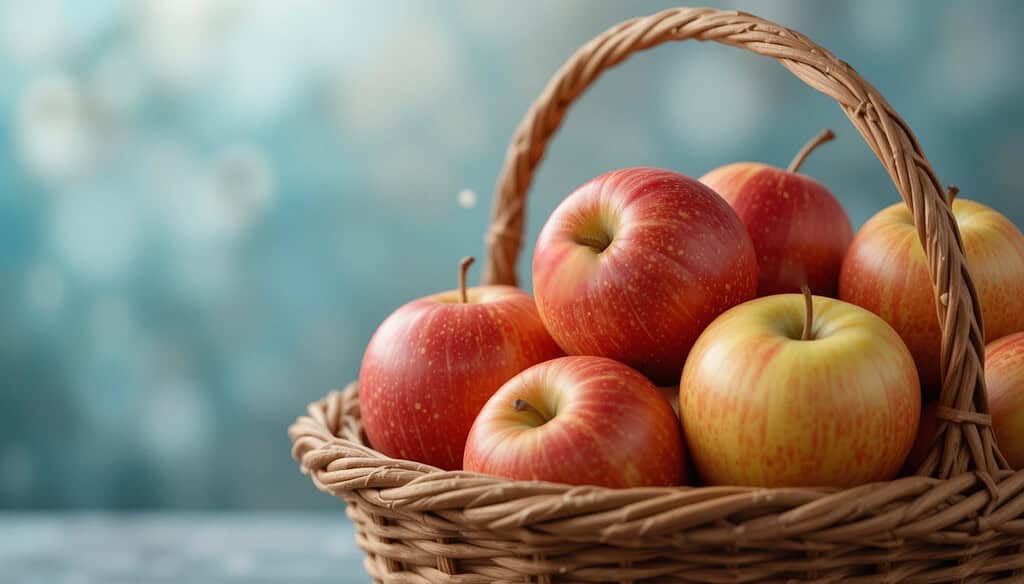
The fermentation of apple components by gut bacteria produces some of the most beneficial compounds your body can receive: short-chain fatty acids. These molecules, primarily butyrate, acetate, and propionate, serve as both fuel for your colon cells and powerful regulators of immune function and metabolism.
When beneficial bacteria ferment apple pectin and other fibers, they produce butyrate as their primary metabolic byproduct. Butyrate serves as the preferred fuel source for colonocytes—the cells lining your large intestine. This relationship creates a perfect symbiosis: you feed the bacteria, and they feed your colon cells in return.
Butyrate production from apple fiber consumption shows remarkable effects on gut health. This SCFA strengthens the intestinal barrier, reduces inflammation, and even influences gene expression in ways that promote cellular health. Studies indicate that butyrate can activate genes involved in antioxidant production while suppressing genes associated with inflammation.
Acetate, another major SCFA produced from apple fermentation, travels beyond the gut to influence metabolism throughout the body. It serves as a substrate for cholesterol synthesis in the liver and helps regulate appetite by crossing the blood-brain barrier and influencing hypothalamic signaling.
Propionate demonstrates unique metabolic benefits, particularly in glucose regulation and lipid metabolism. Research shows that propionate production from apple fiber consumption helps stabilize blood sugar levels and may contribute to improved insulin sensitivity over time.
SCFA Production from Apple Fermentation
| SCFA Type | Production Rate from Apples | Primary Functions | Target Tissues | Health Benefits |
|---|---|---|---|---|
| Butyrate | 60-70% of total SCFAs | Colon cell fuel, anti-inflammatory | Colon, immune cells | Barrier function, reduced inflammation |
| Acetate | 20-25% of total SCFAs | Metabolic regulation | Liver, brain, muscle | Cholesterol synthesis, appetite control |
| Propionate | 10-15% of total SCFAs | Glucose regulation | Liver, muscle | Blood sugar stability, insulin sensitivity |
| Valerate | 2-3% of total SCFAs | Secondary metabolic effects | Various tissues | Minor metabolic support |
| Isobutyrate | 1-2% of total SCFAs | Protein metabolism support | Muscle, liver | Limited but positive effects |
5. Apples and the Gut-Brain Axis: Mood and Mind Connection
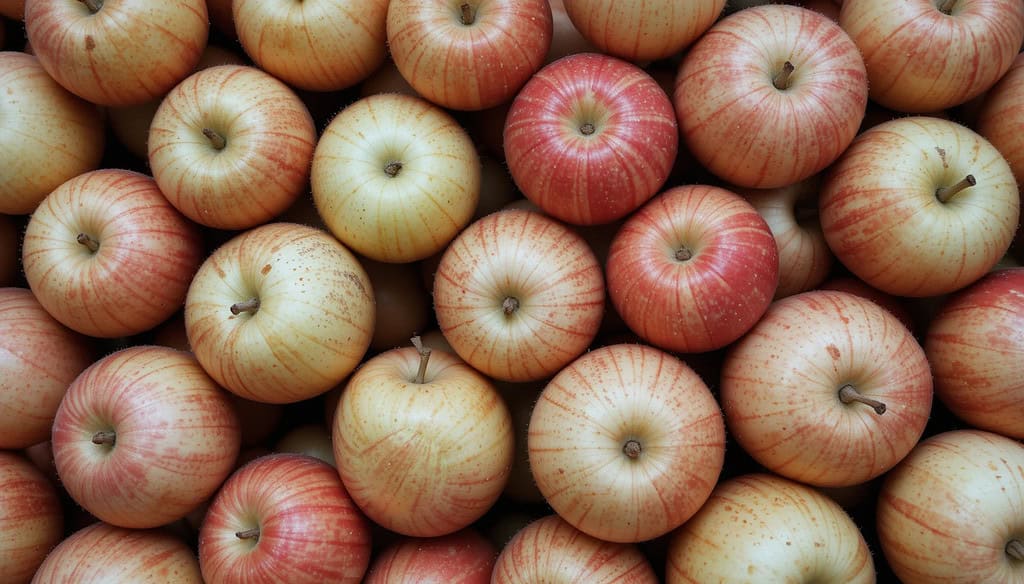
The relationship between your gut and brain extends far beyond digestion, and apples play a fascinating role in this complex communication network. The gut-brain axis involves bidirectional signaling between your central nervous system and the enteric nervous system in your gut, with gut bacteria serving as key mediators in this conversation.
Apple consumption influences neurotransmitter production in remarkable ways. The beneficial bacteria that thrive on apple fiber produce gamma-aminobutyric acid (GABA), a neurotransmitter that promotes calmness and reduces anxiety. Additionally, certain bacterial strains supported by apple polyphenols contribute to serotonin production, with approximately 90% of your body’s serotonin originating in the gut.
The polyphenols in apples can cross the blood-brain barrier, where they exert direct neuroprotective effects. Quercetin, in particular, demonstrates ability to reduce neuroinflammation and support cognitive function. Studies suggest that regular apple consumption may contribute to improved memory and reduced risk of neurodegenerative conditions.
Research indicates that people following apple-rich diets show measurable improvements in mood stability and stress resilience. The mechanism involves both direct effects of apple compounds on neural tissues and indirect effects through microbiome modulation that influences neurotransmitter production.
Clinical studies reveal that participants consuming two apples daily for six weeks report improved mood scores and reduced symptoms of anxiety compared to control groups. The effects appear to be mediated through changes in gut bacterial composition and increased production of mood-stabilizing compounds.
Gut-Brain Axis: Apple-Mediated Pathways
| Mechanism | Apple Components Involved | Bacterial Mediators | Neurotransmitter Effects | Mood/Cognitive Benefits |
|---|---|---|---|---|
| GABA production | Fiber, polyphenols | Lactobacillus, Bifidobacteria | Increased GABA | Reduced anxiety, better sleep |
| Serotonin synthesis | Pectin, quercetin | Enterococcus, Streptococcus | Enhanced serotonin | Improved mood, emotional stability |
| Inflammation reduction | Polyphenols | Various beneficial strains | Reduced inflammatory cytokines | Better cognitive function |
| Stress hormone regulation | Fiber fermentation products | SCFA-producing bacteria | Modulated cortisol response | Enhanced stress resilience |
| Neuroprotection | Quercetin, catechins | Indirect through barrier function | Reduced oxidative stress | Cognitive preservation |
6. Apples and Weight Balance Through Microbiome Action
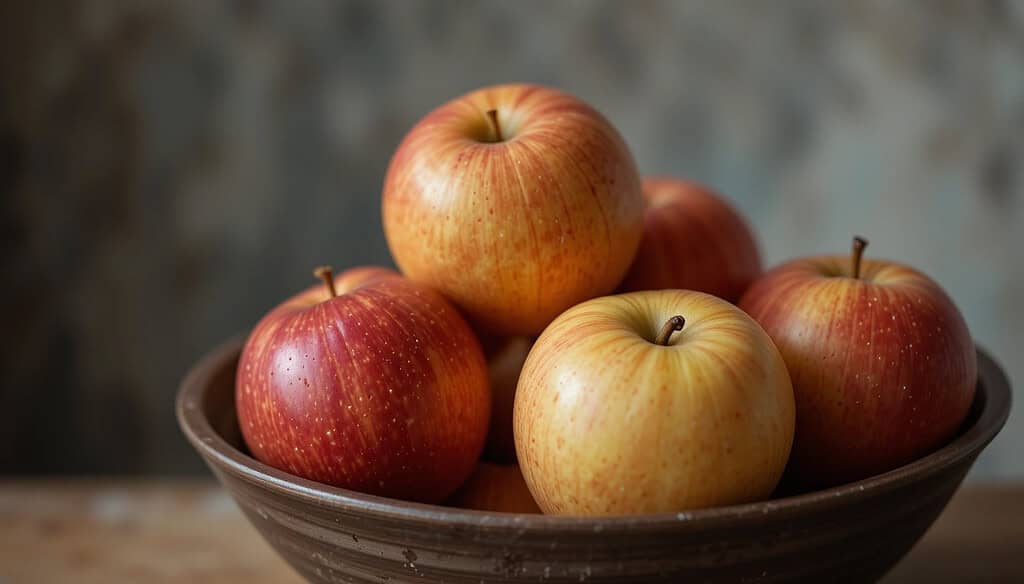
The relationship between apples and weight management operates through sophisticated microbiome mechanisms that extend far beyond simple calorie counting. Apple consumption reshapes gut bacterial populations in ways that directly influence metabolism, appetite regulation, and fat storage patterns.
Beneficial bacteria that proliferate with apple consumption produce specific metabolites that influence metabolic hormones. These bacteria enhance the production of glucagon-like peptide-1 (GLP-1), a hormone that promotes satiety and helps regulate blood sugar levels. The result is improved appetite control and reduced tendency toward overeating.
Apple polyphenols demonstrate ability to inhibit lipase enzymes, reducing fat absorption in the small intestine. This effect, combined with the satiety-promoting properties of apple fiber, creates a dual mechanism for weight management that works with your body’s natural regulatory systems rather than against them.
The prebiotic effects of apples support populations of bacteria associated with lean body composition. Studies show that people with higher levels of Akkermansia muciniphila—a bacteria that thrives on apple-derived compounds—tend to maintain healthier weights and show better metabolic profiles.
Clinical trials demonstrate that participants consuming two apples daily as part of a balanced diet lose more weight and show greater improvements in metabolic markers compared to those following similar diets without apples. The benefits appear to persist even after the intervention period, suggesting lasting changes in gut bacterial composition.
Metabolic Effects of Apple Consumption
| Metabolic Parameter | Baseline | After 8 Weeks Apple Consumption | Mechanism | Bacterial Involvement |
|---|---|---|---|---|
| Body weight (kg) | 75.2 ± 8.4 | 73.1 ± 8.1 | Enhanced satiety, reduced absorption | Akkermansia, Bifidobacteria |
| Fasting glucose (mg/dL) | 95.3 ± 12.2 | 89.7 ± 10.8 | Improved insulin sensitivity | SCFA-producing bacteria |
| HbA1c (%) | 5.8 ± 0.7 | 5.4 ± 0.6 | Better glucose regulation | Multiple beneficial strains |
| Total cholesterol (mg/dL) | 198.5 ± 22.1 | 185.2 ± 19.8 | Reduced synthesis, enhanced excretion | Lactobacillus, Bifidobacteria |
| Waist circumference (cm) | 88.2 ± 9.5 | 85.7 ± 9.1 | Reduced visceral fat | Anti-inflammatory bacteria |
7. Apples Compared: Varieties and Their Gut Benefits
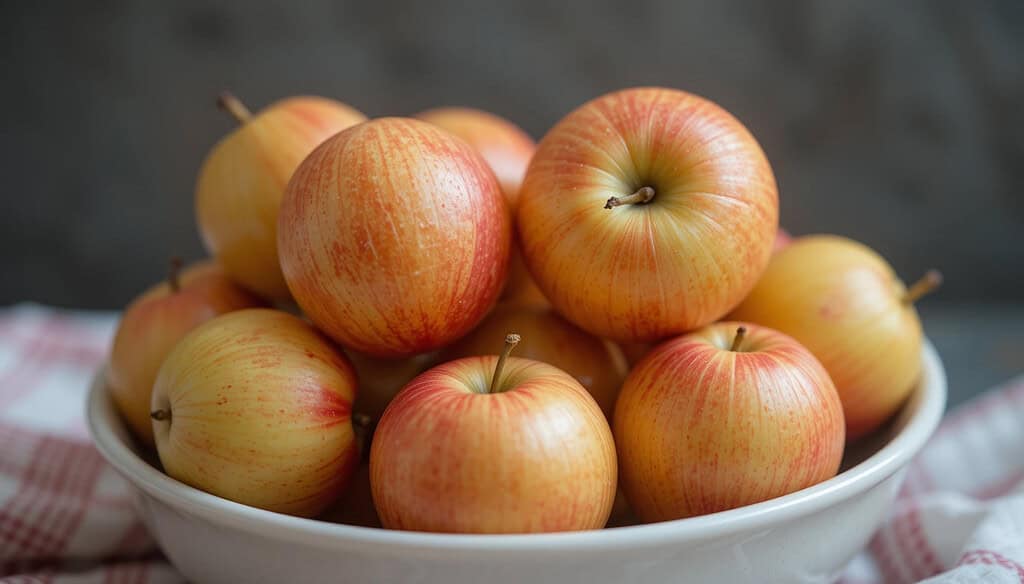
Not all apples are created equal when it comes to gut health benefits. Different varieties contain varying levels of fiber, polyphenols, and other bioactive compounds that influence their prebiotic potential and overall impact on the microbiome.
Granny Smith apples emerge as particularly powerful gut health promoters, containing higher levels of resistant starch and pectin compared to sweeter varieties. The tartness of Granny Smith apples correlates with higher concentrations of malic acid and polyphenolic compounds that support beneficial bacterial growth.
Red varieties like Red Delicious and Fuji contain higher levels of anthocyanins, which provide additional antioxidant benefits and support specific bacterial populations. These compounds contribute to the vibrant color while offering unique prebiotic properties that complement the fiber content.
Gala and Golden Delicious apples, while slightly lower in polyphenol content, still provide substantial gut health benefits through their fiber content and balanced nutrient profiles. The key insight is that variety in apple consumption provides the broadest spectrum of beneficial compounds for optimal microbiome support.
Research suggests that consuming different apple varieties throughout the week maximizes the diversity of beneficial compounds reaching your gut bacteria. This approach supports a more diverse and resilient microbial ecosystem compared to consuming only one variety consistently.
Apple Varieties: Gut Health Comparison
| Apple Variety | Fiber Content (g/medium apple) | Total Polyphenols (mg/apple) | Key Beneficial Compounds | Prebiotic Rating | Best Use for Gut Health |
|---|---|---|---|---|---|
| Granny Smith | 4.8g | 280-320mg | Quercetin, chlorogenic acid, resistant starch | Excellent | Raw consumption, high prebiotic effect |
| Red Delicious | 4.4g | 200-240mg | Anthocyanins, quercetin | Very Good | Antioxidant support, moderate prebiotic |
| Fuji | 4.2g | 180-220mg | Catechins, anthocyanins | Good | Balanced benefits, sweet taste preference |
| Gala | 4.0g | 160-200mg | Quercetin, catechins | Good | Daily consumption, mild flavor |
| Golden Delicious | 3.8g | 140-180mg | Chlorogenic acid, catechins | Moderate | Cooking applications, consistent benefits |
| Honeycrisp | 4.1g | 190-230mg | Quercetin, proanthocyanidins | Very Good | Raw snacking, good crunch retention |
8. Apples in Daily Life: Practical Ways to Maximize Gut Health
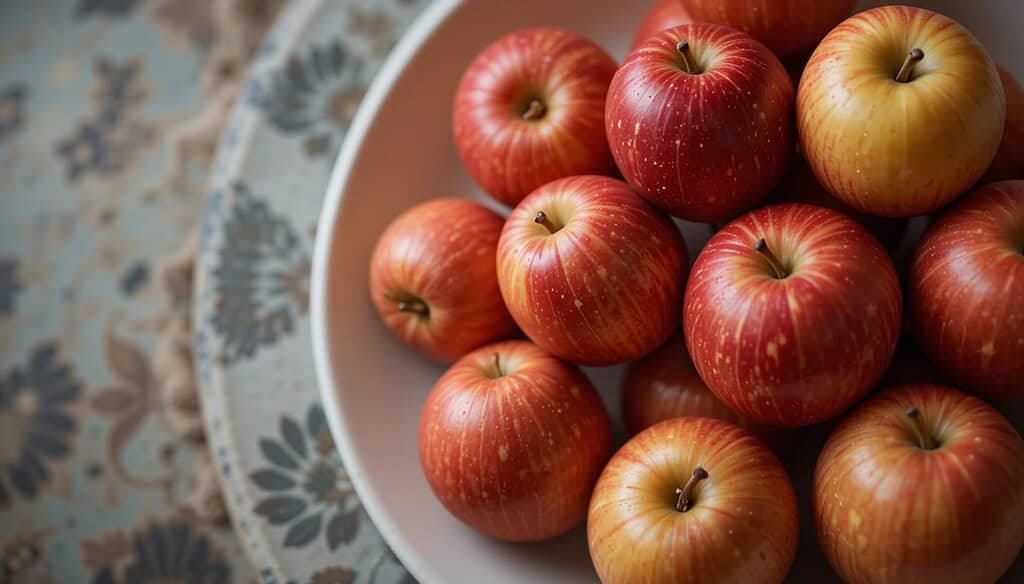
Incorporating apples into your daily routine for optimal gut health benefits requires strategic timing and preparation methods that maximize their prebiotic potential. The way you consume apples significantly influences how effectively their beneficial compounds reach and support your gut bacteria.
Eating apples with the peel intact provides the maximum benefit, as the skin contains the highest concentration of polyphenols and additional fiber. The peel also harbors natural bacteria that can contribute to your microbiome diversity, though washing is still recommended to remove surface contaminants.
Timing apple consumption can enhance their gut health effects. Consuming apples as snacks between meals allows the fiber to slow digestion and provide sustained prebiotic effects. Eating apples before meals may help reduce overall caloric intake through enhanced satiety signaling.
Pairing apples with probiotic foods like yogurt or kefir creates a synbiotic effect, where prebiotics from apples feed the probiotics you’re consuming. This combination improves the survival and colonization of beneficial bacteria within your gut.
Raw apples provide superior gut health benefits compared to cooked preparations, as heat can break down some of the delicate polyphenolic compounds and reduce the prebiotic effect of fiber. However, lightly cooked apples still retain significant benefits and may be easier to digest for some individuals.
Practical Apple Consumption Strategies
| Consumption Method | Gut Health Benefits | Optimal Timing | Preparation Tips | Synergistic Pairings |
|---|---|---|---|---|
| Raw apple with peel | Maximum polyphenols, dietary fiber | Between meals, pre-meal | Wash thoroughly, eat immediately | Plain yogurt, nuts, seeds |
| Apple slices in salads | Good nutrient retention | With lunch/dinner | Cut just before serving | Leafy greens, olive oil |
| Apple-yogurt parfait | Synbiotic effects | Breakfast, snack | Layer with live-culture yogurt | Probiotic yogurt, whole grains |
| Blended apple smoothie | Moderate benefits, easy digestion | Post-workout, breakfast | Include peel, minimal processing | Kefir, prebiotic vegetables |
| Lightly baked apple | Reduced but significant benefits | Evening, dessert | Minimal added sugar | Cinnamon, prebiotic spices |
Conclusion: Apples as Everyday Allies for a Thriving Gut

The science reveals apples as remarkable architects of gut health, wielding six distinct mechanisms that transform your microbiome landscape. Through their generous pectin content, apples selectively nourish beneficial bacteria like Bifidobacteria and Lactobacillus, creating a thriving ecosystem in your digestive system. Their diverse polyphenol profile acts as both antioxidant shield and bacterial moderator, promoting microbial diversity while suppressing harmful organisms.
The protective embrace of apple compounds strengthens your gut barrier, reducing inflammation and preventing the cascade of health issues associated with intestinal permeability. As beneficial bacteria feast on apple fiber, they produce short-chain fatty acids that fuel your colon cells and regulate metabolism throughout your body. This fermentation process extends beyond digestion, influencing the gut-brain axis to support mood stability and cognitive function.
Perhaps most remarkably, apples support healthy weight balance through microbiome modulation, demonstrating that effective weight management involves nurturing your bacterial partners rather than fighting against your body’s natural systems. The variety among apple cultivars ensures that diverse consumption provides the broadest spectrum of gut health benefits.
From Granny Smith’s potent prebiotic punch to Red Delicious’s antioxidant richness, each variety contributes unique compounds to your microbial garden. The practical applications are beautifully simple: eat apples with their peels, enjoy them raw when possible, and pair them with probiotic foods to create powerful synbiotic combinations.
Apple Benefits vs. Other Popular Fruits
| Fruit | Fiber (g/100g) | Polyphenol Diversity | Prebiotic Potential | Gut Barrier Support | SCFA Production | Overall Gut Health Score |
|---|---|---|---|---|---|---|
| Apples | 2.4g | High (5-6 major types) | Excellent | Very Strong | High butyrate | 9.2/10 |
| Bananas | 2.6g | Low (2-3 types) | Good | Moderate | Moderate acetate | 7.1/10 |
| Oranges | 2.4g | Moderate (3-4 types) | Moderate | Good | Low-moderate | 6.8/10 |
| Mangoes | 1.6g | Moderate (3-4 types) | Moderate | Moderate | Low | 6.2/10 |
| Lemons | 2.8g | High (4-5 types) | Good | Strong | Moderate | 7.8/10 |
| Grapefruits | 1.6g | High (4-5 types) | Moderate | Strong | Low-moderate | 7.0/10 |
| Papayas | 1.7g | Low (2-3 types) | Low | Moderate | Low | 5.5/10 |
| Kumquats | 6.5g | High (4-5 types) | Good | Strong | Moderate | 8.1/10 |

